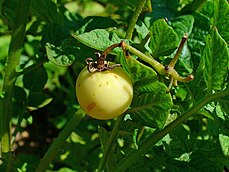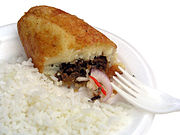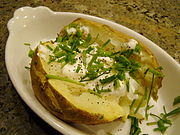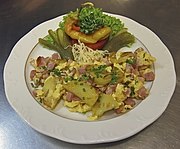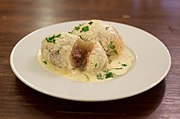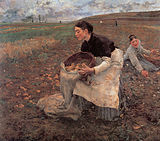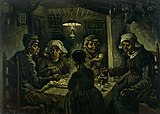Potato
| Potato | |
|---|---|

| |
| Potatocultivarsappear in a variety of colors, shapes, and sizes. | |
| Scientific classification | |
| Kingdom: | Plantae |
| Clade: | Tracheophytes |
| Clade: | Angiosperms |
| Clade: | Eudicots |
| Clade: | Asterids |
| Order: | Solanales |
| Family: | Solanaceae |
| Genus: | Solanum |
| Species: | S. tuberosum
|
| Binomial name | |
| Solanum tuberosum | |
| Synonyms | |
|
seelist | |
Thepotato(/pəˈteɪtoʊ/) is astarchyroot vegetablenative to the Americas that is consumed as astaple foodin many parts of the world. Potatoes aretubersof the plantSolanum tuberosum,aperennialin the nightshade familySolanaceae.
Wild potatospeciescan be found from the southern United States tosouthern Chile.Genetic studies show that the cultivated potato has a single origin, in the area of present-day southernPeruand extreme northwesternBolivia.Potatoes were domesticated there about 7,000–10,000 years ago from a species in theS. brevicaulecomplex. Manyvarietiesof the potato are cultivated in theAndesregion of South America, where the species isindigenous.
The Spanishintroduced potatoes to Europein the second half of the 16th century from the Americas. They are astaple foodin many parts of the world and an integral part of much of the world'sfood supply.Following millennia ofselective breeding,there are now over 5,000different varieties of potatoes.The potato remains an essential crop in Europe, especially Northern and Eastern Europe, where per capita production is still the highest in the world, while the most rapid expansion in production during the 21st century was insouthernand eastern Asia, with China and India leading the world production as of 2021.
Like the tomato and the nightshades, the potato is in the genusSolanum;the aerial parts of the potato contain the toxinsolanine.Normal potato tubers that have been grown and stored properly produceglycoalkaloidsin negligible amounts, but, if sprouts and potato skins are exposed to light, tubers can become toxic.
Etymology
The English word "potato" comes from Spanishpatata,in turn fromTaínobatata,which means "sweet potato",not the plant now known as simply" potato ".[1]
The name "spud" for a potato is from the 15th centuryspudde,a short knife or dagger, probably related to Danishspyd,"spear". From around 1840, the name transferred to the tuber itself.[2]
At least six languages—Afrikaans, Dutch, French, (West) Frisian, Hebrew, Persian[3]and some variants of German—use a term for "potato" that means "earth apple" or "ground apple".[4][5]
Description
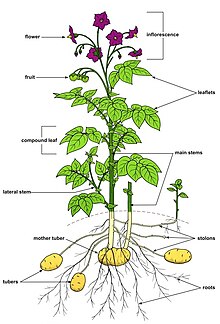
Potato plants are herbaceousperennialsthat grow up to 1 metre (3.3 ft) high. The stems are hairy. The leaves have roughly four pairs ofleaflets.The flowers range from white or pink to blue or purple; they are yellow at the centre, and are insect-pollinated.[6]
The plant developstubers,the potatoes of commerce, to store nutrients. These are not roots but stems that form from thickenedrhizomesat the tips of long thinstolons.On the surface of the tubers there are "eyes," which act as sinks to protect the vegetative buds from which the stems originate. The "eyes" are arranged in helical form. In addition, the tubers have small holes that allow breathing, calledlenticels.The lenticels are circular and their number varies depending on the size of the tuber and environmental conditions.[7]Tubers form in response to decreasing day length, although this tendency has been minimized in commercial varieties.[8]
After flowering, potato plants producesmall green fruitsthat resemble greencherry tomatoes,each containing about 300 very smallseeds.[9]
Phylogeny
Wild and cultivated potatoes, like thetomato,belong to the genusSolanum,which is a member of the nightshade family, theSolanaceae.That is a diverse family of flowering plants, often poisonous, that includes the mandrake (Mandragora), deadly nightshade (Atropa), and tobacco (Nicotiana), as shown in the outline phylogenetic tree (many branches omitted). The most commonly cultivated potato isS. tuberosum;there are several other species.[10]
| Solanaceae |
| ||||||||||||||||||||||||||||||||||||

The major species grown worldwide isS. tuberosum(atetraploidwith 48chromosomes), and modern varieties of this species are the most widely cultivated. There are also fourdiploidspecies (with 24 chromosomes):S. stenotomum,S. phureja,S. goniocalyx,andS. ajanhuiri.There are twotriploidspecies (with 36 chromosomes):S. chauchaandS. juzepczukii.There is onepentaploidcultivated species (with 60 chromosomes):S. curtilobum.[11]
There are two major subspecies ofS. tuberosum.[11]The Andean potato,S. tuberosum andigena,is adapted to the short-day conditions prevalent in the mountainous equatorial and tropical regions where it originated. The Chilean potatoS. tuberosum tuberosum,native to theChiloé Archipelago,is in contrast adapted to the long-day conditions prevalent in the higher latitude region of southern Chile.[12]
History
Domestication
Wild potatospeciesoccur from the southern United States to southern Chile.[13]The potato was first domesticated in southernPeruand northwesternBolivia[14]by pre-Columbian farmers, aroundLake Titicaca.[15]Potatoes were domesticated there about 7,000–10,000 years ago from a species in theS. brevicaulecomplex.[14][15][16]
The earliest archaeologically verified potato tuber remains have been found at the coastal site ofAncon(centralPeru), dating to 2500 BC.[17][18]The most widely cultivated variety,Solanum tuberosum tuberosum,is indigenous to theChiloé Archipelago,and has been cultivated by thelocal indigenous peoplesince before theSpanish conquest.[12][19]
Spread
Following theSpanish conquest of the Inca Empire,the Spanish introduced the potato to Europe in the second half of the 16th century as part of theColumbian exchange.The staple was subsequently conveyed by European mariners (possibly including theRussian-American Company) to territories and ports throughout the world, especially their colonies.[20]European and colonial farmers were slow to adopt farming potatoes, but after 1750 they became an important food staple and field crop[20]and played a major role in the European 19th century population boom.[16]According to conservative estimates, the introduction of the potato was responsible for a quarter of the growth inOld Worldpopulation and urbanization between 1700 and 1900.[21]However, lack ofgenetic diversity,due to the very limited number of varieties initially introduced, left the crop vulnerable to disease. In 1845, a plant disease known as late blight, caused by the fungus-likeoomycetePhytophthora infestans,spread rapidly through the poorer communities of western Ireland as well as parts of theScottish Highlands,resulting in the crop failures that led to theGreat Irish Famine.[22][20]
TheInternational Potato Center,based inLima,Peru, holds 4,870 types of potatogermplasm,most of which are traditionallandracecultivars.[23]In 2009 a draft sequence of the potato genome was made, containing 12 chromosomes and 860 million base pairs, making it a medium-sized plant genome.[24]
It had been thought that most potatocultivarsderived from a singleoriginin southernPeruand extreme NorthwesternBolivia,from a species in theS. brevicaulecomplex.[14][15][16]DNA analysis however shows that more than 99% of all current varieties of potatoes are direct descendants of a subspecies that once grew in thelowlandsof south-central Chile.[25]
Most modern potatoes grown in North America arrived through European settlement and not independently from the South American sources. At least one wild potato species,S. fendleri,occurs in North America; it is used in breeding for resistance to anematodespecies that attacks cultivated potatoes. A secondary center of genetic variability of the potato is Mexico, where important wild species that have been used extensively in modern breeding are found, such as the hexaploidS. demissum,used as a source of resistance to the devastatinglate blightdisease (Phytophthora infestans).[22]Another relative native to this region,Solanum bulbocastanum,has been used to genetically engineer the potato to resist potato blight.[26]Many suchwild relativesare useful for breedingresistancetoP. infestans.[27]
Little of thediversityfound inSolanumancestral andwild relativesis found outside the original South American range.[28]This makes these South American species highly valuable in breeding.[28]The importance of the potato to humanity is recognised in theUnited NationsInternational Day of Potato, to be celebrated on 30 May each year, starting in 2024.[29]
Breeding
Potatoes, bothS. tuberosumand most of its wild relatives, areself-incompatible:they bear no useful fruit when self-pollinated. This trait is problematic for crop breeding, as all sexually-produced plants must behybrids.The gene responsible for self-incompatibility, as well as mutations to disable it, are now known. Self-compatibility has successfully been introduced both to diploid potatoes (including a special line ofS. tuberosum) byCRISPR-Cas9.[30]Plants having a 'Sli' gene produce pollen which is compatible to its own parent and plants with similar S genes.[31]This gene was cloned byWageningen UniversityandSolyntain 2021, which would allow for faster and more focused breeding.[30][32]
Diploidhybrid potato breeding is a recent area of potato genetics supported by the finding that simultaneoushomozygosityandfixationof donor alleles is possible.[33]Wild potato species useful for breedingblight resistance includeSolanum desmissumandS. stoloniferum,among others.[34]
Varieties

There are some 5,000 potato varieties worldwide, 3,000 of them in theAndesalone — mainly in Peru, Bolivia, Ecuador, Chile, and Colombia. Over 100 cultivars might be found in a single valley, and a dozen or more might be maintained by a single agricultural household.[35][36] TheEuropean Cultivated Potato Databaseis an online collaborative database of potato variety descriptions updated and maintained by theScottish Agricultural Science Agencywithin the framework of the European Cooperative Programme for Crop Genetic Resources Networks—which is run by theInternational Plant Genetic Resources Institute.[37] Around 80 varieties are commercially available in the UK.[38]
For culinary purposes, varieties are often differentiated by their waxiness: floury or mealybakingpotatoes have morestarch(20–22%) than waxyboilingpotatoes (16–18%). The distinction may also arise from variation in the comparative ratio of two different potato starch compounds:amyloseandamylopectin.Amylose, a long-chain molecule, diffuses from the starch granule when cooked in water, and lends itself to dishes where the potato is mashed. Varieties that contain a slightly higher amylopectin content, which is a highly branched molecule, help the potato retain its shape after being boiled in water.[39]Potatoes that are good for makingpotato chipsor potato crisps are sometimes called "chipping potatoes", which means they meet the basic requirements of similar varietal characteristics, being firm, fairly clean, and fairly well-shaped.[40]
Immature potatoes may be sold fresh from the field as "creamer"or"new"potatoes and are particularly valued for their taste. They are typically small in size and tender, with a loose skin, and flesh containing a lower level ofstarchthan other potatoes. In the United States they are generally either aYukon Gold potatoor a red potato, called gold creamers or red creamers respectively.[41][42]In the UK, theJersey Royalis a famous type of new potato.[43]
Dozens of potatocultivarshave beenselectively bredspecifically for their skin or fleshcolor,including gold, red, and blue varieties.[44]These contain varying amounts ofphytochemicals,includingcarotenoidsfor gold/yellow orpolyphenolsfor red or blue cultivars.[45]Carotenoid compounds includeprovitamin AAlpha -caroteneandbeta-carotene,which are converted to theessential nutrient,vitamin A,during digestion.Anthocyaninsmainly responsible for red or blue pigmentation in potato cultivars do not have nutritional significance, but are used for visual variety and consumer appeal.[46]In 2010, potatoes werebioengineeredspecifically for these pigmentation traits.[47]
Genetic engineering

Genetic research has produced severalgenetically modifiedvarieties. 'New Leaf', owned byMonsanto Company,incorporates genes fromBacillus thuringiensis(source of mostBttoxinsintranscrop use), which confers resistance to theColorado potato beetle;'New Leaf Plus' and 'New Leaf Y', approved by US regulatory agencies during the 1990s, also include resistance toviruses.McDonald's,Burger King,Frito-Lay,andProcter & Gambleannounced they would not usegenetically modified potatoes,and Monsanto published its intent to discontinue the line in March 2001.[48]
Potato starch contains two types ofglucan,amyloseandamylopectin,the latter of which is most industrially useful. Waxy potato varieties producewaxy potato starch,which is almost entirely amylopectin, with little or no amylose.BASFdeveloped the 'Amflora' potato, which was modified to expressantisense RNAto inactivate the gene forgranule bound starch synthase,an enzyme which catalyzes the formation of amylose.[49]'Amflora' potatoes therefore produce starch consisting almost entirely ofamylopectin,and are thus more useful for the starch industry. In 2010, the European Commission cleared the way for 'Amflora' to be grown in the European Union for industrial purposes only—not for food. Nevertheless, under EU rules, individual countries have the right to decide whether they will allow this potato to be grown on their territory. Commercial planting of 'Amflora' was expected in the Czech Republic and Germany in the spring of 2010, and Sweden and the Netherlands in subsequent years.[50]
The 'Fortuna' GM potato variety developed by BASF was made resistant tolate blightbyintrogressingtwo resistance genes,blb1andblb2,fromS. bulbocastanum,a wild potato native to Mexico.[51][52][53]Rpi-blb1is anucleotide-binding leucine-rich repeat(NB-LRR/NLR), an R-gene-produced immunoreceptor.[51]
In October 2011 BASF requested cultivation and marketing approval as a feed and food from the EFSA. In 2012, GMO development in Europe was stopped by BASF.[54][55]In November 2014, theUnited States Department of Agriculture(USDA) approved a genetically modified potato developed bySimplot,which contains genetic modifications that prevent bruising and produce lessacrylamidewhen fried than conventional potatoes; the modifications do not cause new proteins to be made, but rather prevent proteins from being made viaRNA interference.[56]
Genetically modified varieties have met public resistance in the U.S. and in the European Union.[57][58]
Cultivation
Seed potatoes
Potatoes are generally grown from "seed potatoes", tubers specifically grown to be free from disease[clarification needed]and to provide consistent and healthy plants. To be disease free, the areas where seed potatoes are grown are selected with care. In the US, this restricts production of seed potatoes to only 15 states out of all 50 states where potatoes are grown. These locations are selected for their cold, hard winters that kill pests and summers with long sunshine hours for optimum growth.[59]In the UK, most seed potatoes originate inScotland,in areas where westerly winds reduceaphidattacks and the spread ofpotato viruspathogens.[60]
Phases of growth
Potato growth can be divided into five phases. During the first phase, sprouts emerge from the seed potatoes and root growth begins. During the second,photosynthesisbegins as the plant develops leaves and branches above-ground andstolonsdevelop from lower leafaxilson the below-ground stem. In the third phase the tips of the stolons swell, forming newtubers,and the shoots continue to grow, with flowers typically developing soon after. Tuber bulking occurs during the fourth phase, when the plant begins investing the majority of its resources in its newly formed tubers. At this phase, several factors are critical to a good yield: optimalsoil moistureand temperature, soil nutrient availability and balance, and resistance topest attacks.The fifth phase is the maturation of the tubers: the leaves and stems senesce and the tuber skins harden.[61][62]
New tubers may start growing at the surface of the soil. Since exposure to light leads to an undesirable greening of the skins and the development ofsolanineas a protection from the sun's rays, growers cover surface tubers. Commercial growers cover them by piling additional soil around the base of the plant as it grows (called "hilling" up, or in British English "earthing up" ). An alternative method, used by home gardeners and smaller-scale growers, involves covering the growing area withmulchessuch as straw or plastic sheets.[63]
At farm scale, potatoes require a well-drained neutral or mildly acidic soil (pH6 or 7) such as a sandyloam.The soil is prepared using deep tillage, for example with achisel plowor ripper. In areas where irrigation is needed, the field is leveled using a landplane so that water can be supplied evenly. Manure can be added after initial irrigation; the soil is then broken up with adisc harrow.The potatoes are planted using apotato plantermachine in rows 80 centimetres (31 in) apart.[64]At garden scale, potatoes are planted in trenches or individual holes some 15 centimetres (5.9 in) deep in soil, preferably with additional organic matter such as garden compost or manure. Alternatively, they can be planted in containers or bags filled with a free-draining compost.[65] Potatoes are sensitive to heavyfrosts,which damage them in the ground or when stored.[66]
-
Planting
-
Field inFort Fairfield, Maine
-
Immature potato plants
-
Potatoes grown in a tall bag are common in gardens as they minimize digging.
Pests and diseases
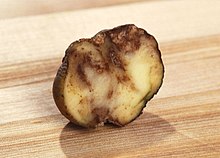
The historically significantPhytophthora infestans,the cause oflate blight,remains an ongoing problem in Europe[22]and the United States.[67]Other potato diseases includeRhizoctonia,Sclerotinia,Pectobacterium carotovorum(black leg),powdery mildew,powdery scabandleafroll virus.[68][69]
Insects that commonly transmit potato diseases or damage the plants include theColorado potato beetle,thepotato tuber moth,the green peach aphid (Myzus persicae), thepotato aphid,Tuta absoluta,beet leafhoppers,thrips,andmites.The Colorado potato beetle is considered the most important insect defoliator of potatoes, devastating entire crops.[70]Thepotato cyst nematodeis a microscopic worm that feeds on the roots, thus causing the potato plants to wilt. Since its eggs can survive in the soil for several years,crop rotationis recommended.[71]
Harvest

On a small scale, potatoes can be harvested using a hoe or spade, or simply by hand. Commercial harvesting is done with largepotato harvesters,which scoop up the plant and surrounding earth. This is transported up an apron chain consisting of steel links several feet wide, which separates some of the earth. The chain deposits into an area where further separation occurs. The most complex designs use vine choppers and shakers, along with a blower system to separate the potatoes from the plant. The result is then usually run past workers who continue to sort out plant material, stones, and rotten potatoes before the potatoes are continuously delivered to a wagon or truck. Further inspection and separation occurs when the potatoes are unloaded from the field vehicles and put into storage.[72]
Potatoes are usually cured after harvest to improve skin-set. Skin-set is the process by which the skin of the potato becomes resistant to skinning damage. Potato tubers may be susceptible to skinning at harvest and suffer skinning damage during harvest and handling operations. Curing allows the skin to fully set and any wounds to heal. Wound-healing prevents infection and water-loss from the tubers during storage. Curing is normally done at relatively warm temperatures (10 to 16 °C or 50 to 60 °F) with high humidity and good gas-exchange if at all possible.[73]
Storage

Storage facilities need to be carefully designed to keep the potatoes alive and slow the natural process of sprouting which involves the breakdown of starch. It is crucial that the storage area be dark, ventilated well, and, for long-term storage, maintained at temperatures near 4 °C (39 °F). For short-term storage, temperatures of about 7 to 10 °C (45 to 50 °F) are preferred.[74]
Temperatures below 4 °C (39 °F) convert the starch in potatoes into sugar, which alters their taste and cooking qualities and leads to higheracrylamidelevels in the cooked product, especially in deep-fried dishes. The discovery of acrylamides in starchy foods in 2002 has caused concern, but it is not likely that the acrylamides in food, even if it is somewhat burnt, causes cancer in humans.[75]
Chemicals are used to suppress sprouting of tubers during storage.Chlorprophamis the main chemical used, but it has been banned in the EU over toxicity concerns.[76]Alternatives includeethylene,spearmint and orange oils, and1,4-dimethylnaphthalene.[76]
Under optimum conditions in commercial warehouses, potatoes can be stored for up to 10–12 months.[74]The commercial storage and retrieval of potatoes involves several phases: firstdryingsurface moisture;wound healingat 85% to 95%relative humidityand temperatures below 25 °C (77 °F); a stagedcooling phase;aholdingphase; and areconditioningphase, during which the tubers are slowly warmed.Mechanical ventilationis used at various points during the process to prevent condensation and the accumulation of carbon dioxide.[74]
Production
| Potato production – 2021 | |
|---|---|
| Country | Production (millions oftonnes) |
| 94.3 | |
| 54.2 | |
| 21.4 | |
| 18.6 | |
| 18.3 | |
| World | 376 |
| Source:FAOSTATof the United Nations[77] | |
-
Production of potatoes (2019)[78]
-
Potatoes are one of the most widely produced primary crops in the world.
In 2021, world production of potatoes was 376 million tonnes (370,000,000 long tons; 414,000,000 short tons), led by China with 25% of the total. Other major producers were India andUkraine(table).
The world dedicated 18.6 million hectares (46 million acres) to potato cultivation in 2010; the world average yield was 17.4 tonnes per hectare (7.8 short tons per acre). The United States was the most productive country, with a nationwide average yield of 44.3 tonnes per hectare (19.8 short tons per acre).[79]
New Zealand farmers have demonstrated some of the best commercial yields in the world, ranging between 60 and 80 tonnes per hectare, some reporting yields of 88 tonnes of potatoes per hectare.[80][81][82]
There is a big gap among various countries between high and low yields, even with the same variety of potato. Average potato yields in developed economies ranges between 38 and 44 metric tons per hectare (15 and 18 long ton/acre; 17 and 20 short ton/acre). China and India accounted for over a third of world's production in 2010, and had yields of 14.7 and 19.9 metric tons per hectare (5.9 and 7.9 long ton/acre; 6.6 and 8.9 short ton/acre) respectively.[79]The yield gap between farms in developing economies and developed economies represents an opportunity loss of over 400 million metric tons (440 million short tons; 390 million long tons) of potato, or an amount greater than 2010 world potato production. Potato crop yields are determined by factors such as the crop breed, seed age and quality, crop management practices and the plant environment. Improvements in one or more of these yield determinants, and a closure of the yield gap, could be a major boost to food supply and farmer incomes in the developing world.[83][84]Thefood energyyield of potatoes—about 95 gigajoules per hectare (9.2 million kilocalories per acre)—is higher than that of maize (78 GJ/ha or 7.5 million kcal/acre), rice (77 GJ/ha or 7.4 million kcal/acre), wheat (31 GJ/ha or 3 million kcal/acre), orsoybeans(29 GJ/ha or 2.8 million kcal/acre).[85]
Impact of climate change on production
Climate changeis predicted to have significant effects on global potato production.[86]Like many crops, potatoes are likely to be affected by changes in atmosphericcarbon dioxide,temperature and precipitation, as well as interactions between these factors.[86]As well as affecting potatoes directly, climate change will also affect the distributions and populations of many potato diseases and pests. While the potato is less important thanmaize,rice,wheatandsoybeans,which are collectively responsible for around two-thirds of all calories consumed by humans (both directly and indirectly as animal feed),[87]it still is one of the world's most important food crops.[88]Altogether, one 2003 estimate suggests that future (2040–2069) worldwide potato yield would be 18-32% lower than it was at the time, driven by declines in hotter areas like Sub-Saharan Africa,[86]unless farmers and potato cultivars can adapt to the new environment.[89]
Potato plants and crop yields are predicted to benefit from theCO2 fertilization effect,[90]which would increasephotosynthetic ratesand therefore growth, reduce water consumption through lowertranspirationfromstomataand increase starch content in the edible tubers.[86]However, potatoes are more sensitive to soil water deficits than some other staple crops like wheat.[91]In the UK, the amount ofarable landsuitable forrainfedpotato production is predicted to decrease by at least 75%.[92]These changes are likely to lead to increased demand forirrigationwater, particularly during the potato growing season.[86]
Potatoes grow best under temperate conditions.[93]Temperatures above 30 °C (86 °F) have negative effects on potato crops, from physiological damage such as brown spots on tubers, to slower growth, premature sprouting, and lower starch content.[94]These effects reduce crop yield, affecting both the number and the weight of tubers. As a result, areas where current temperatures are near the limits of potatoes' temperature range (e.g. much ofsub-Saharan Africa)[86]will likely suffer large reductions in potato crop yields in the future.[93]On the other hand, low temperatures reduce potato growth and present risk of frost damage.[86]
Changes in pests and diseases
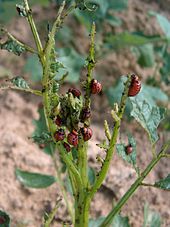
Climate change is predicted to affect many potato pests and diseases. These include:
- Insect pests such as thepotato tuber mothandColorado potato beetle,which are predicted to spread into areas currently too cold for them.[86]
- Aphidswhich act as vectors for many potato viruses and will spread under increased temperatures.[95]
- Pathogens causing potato blackleg disease (e.g.Dickeya) grow and reproduce faster at higher temperatures.[96]
- Bacterial infections such asRalstonia solanacearumwill benefit from higher temperatures and spread more easily through flash flooding.[86]
- Late blightbenefits from higher temperatures and wetter conditions.[97]Late blight is predicted to become a greater threat in some areas (e.g. in Finland)[86]and become a lesser threat in others (e.g. in the United Kingdom).[90]
Adaptation strategies
Potato production is expected to decline in many areas due to hotter temperatures and decreased water availability. Conversely, production is predicted to become possible in high altitude and latitude areas where it has been limited by frost damage, such as inCanadaandRussia.[93]This will shift potato production to cooler areas, mitigating much of the projected decline in yield. However, this may trigger competition for land between potato crops and other land uses, mostly due to changes in water and temperature regimes.[93]
The other approach is through the development of varieties or cultivars which would be more adapted to altered conditions. This can be done through 'traditional'plant breeding techniquesandgenetic modification.These techniques allow for the selection of specific traits as a new cultivar is developed. Certain traits, such asheat stresstolerance, drought tolerance, fast growth/early maturation and disease resistance, may play an important role in creating new cultivars able to maintain yields under stressors induced by climate change.[94]
For instance, developing cultivars with greater heat stress tolerance would be critical for maintaining yields in countries with potato production areas near current cultivars' maximum temperature limits (e.g.Sub-Saharan Africa,India).[98]Superior drought resistance can be achieved through improved water use efficiency (amount of food produced per amount of water used) or the ability to recover from short drought periods and still produce acceptable yields. Further, selecting for deeper root systems may reduce the need for irrigation.[99]
Content
Nutrition
| Nutritional value per 100 g (3.5 oz) | |
|---|---|
| Energy | 364 kJ (87 kcal) |
20.1 g | |
| Sugars | 0.9 g |
| Dietary fiber | 1.8 g |
0.1 g | |
1.9 g | |
| Vitamins | Quantity %DV† |
| Thiamine (B1) | 9% 0.11 mg |
| Riboflavin (B2) | 2% 0.02 mg |
| Niacin (B3) | 9% 1.44 mg |
| Pantothenic acid (B5) | 10% 0.52 mg |
| Vitamin B6 | 18% 0.3 mg |
| Folate (B9) | 3% 10 μg |
| Vitamin C | 14% 13 mg |
| Minerals | Quantity %DV† |
| Calcium | 0% 5 mg |
| Iron | 2% 0.31 mg |
| Magnesium | 5% 22 mg |
| Manganese | 6% 0.14 mg |
| Phosphorus | 4% 44 mg |
| Potassium | 13% 379 mg |
| Sodium | 0% 4 mg |
| Zinc | 3% 0.3 mg |
| Other constituents | Quantity |
| Water | 77 g |
| †Percentages estimated usingUS recommendationsfor adults,[100]except for potassium, which is estimated based on expert recommendation fromthe National Academies.[101] | |
In a reference amount of 100 grams (3.5 oz), a boiled potato with skin supplies 87caloriesand is 77% water, 20%carbohydrates(including 2%dietary fiberin the skin and flesh), 2%protein,and contains negligible fat (table). The protein content is comparable to other starchy vegetable staples, as well as grains.[102]
Boiled potatoes are a rich source (20% or more of theDaily Value,DV) ofvitamin B6(23% DV), and contain a moderate amount ofvitamin C(16% DV) andB vitamins,such asthiamine,niacin,andpantothenic acid(10% DV each). Boiled potatoes do not supply significant amounts ofdietary minerals(table).
The potato is rarely eaten raw because raw potato starch is poorly digested by humans.[103]Depending on the cultivar and preparation method, potatoes can have a highglycemic index(GI) and so are often excluded from the diets of individuals trying to follow alow-GI diet.[104][102]There is a lack of evidence on the effect of potato consumption on obesity and diabetes.[102]
In the UK, potatoes are not considered by theNational Health Serviceas counting or contributing towards the recommended dailyfive portions of fruit and vegetables,the 5-A-Day program.[105]
Toxicity
Raw potatoes containtoxicglycoalkaloids,of which the most prevalent are solanine andchaconine.Solanine is found in other plants in the same family,Solanaceae,which includes such plants as deadly nightshade (Atropa belladonna), henbane (Hyoscyamus niger) and tobacco (Nicotianaspp.), as well as food plants like tomato. These compounds, which protect the potato plant from its predators, are especially concentrated in the aerial parts of the plant. The tubers are low in these toxins, unless they are exposed to light, which makes them go green.[106][107]
Exposure to light, physical damage, and age increase glycoalkaloid content within the tuber.[108]Different potato varieties contain different levels of glycoalkaloids. The 'Lenape' variety, released in 1967, was withdrawn in 1970 as it contained high levels of glycoalkaloids.[109]Since then, breeders of new varieties test for this, sometimes discarding an otherwise promisingcultivar.Breeders try to keep glycoalkaloid levels below 200 mg/kg (0.0032 oz/lb). However, when these commercial varieties turn green, theirsolanineconcentrations can go well above this limit,[110]with higher levels in the potato's skin.[111]
Uses
Culinary
Potato dishes vary around the world.Peruvian cuisinenaturally contains the potato as a primary ingredient in many dishes, as around 3,000 varieties of the tuber are grown there.[112]Chuñois afreeze-driedpotato product traditionally made byQuechuaandAymaracommunities ofPeruandBolivia.[113]In the UK, potatoes form part of the traditional dishfish and chips.Roast potatoes are commonly served as part of aSunday roast dinnerand mashed potatoes form a major component of several other traditional dishes, such asshepherd's pie,bubble and squeak,andbangers and mash.New potatoes may be cooked withmintand are often served with butter. In Germany,Northern(Finland, Latvia and especiallyScandinavian countries), Eastern Europe (Russia,BelarusandUkraine) and Poland, newly harvested, early ripening varieties are considered a special delicacy. Boiled whole and served un-peeled withdill,these "new potatoes" are traditionally consumed withBaltic herring.Puddings made from grated potatoes (kugel,kugelis,andpotato babka) are popular items ofAshkenazi,Lithuanian,andBelarusiancuisine.[114]Cepelinai,the national dish ofLithuania,aredumplingsmade from boiled grated potatoes, usually stuffed withminced meat.[115]In Italy, in theFriuliregion, potatoes serve to make a type of pasta calledgnocchi.[116]Potato is used in northern China where rice is not easily grown, a popular dish beingỚt xanh khoai tây ti(qīng jiāo tǔ dòu sī), made with green pepper, vinegar and thin slices of potato. In the winter, roadside sellers in northern China sell roasted potatoes.[117]
-
Pommes frites,also called chips andFrench fries
-
Baked potato with sour cream and chives
-
GermanBauernfrühstück( "farmer's breakfast" )
Other uses
Potatoes are sometimes used to brew alcoholic spirits such asvodka,poitín,akvavit,andbrännvin.[118][119]
Potatoes are used asfodderfor livestock. They may be made intosilagewhich can be stored for some months before use.[120][121]
Potato starchis used in the food industry as a thickener and binder for soups and sauces, in the textile industry as an adhesive, and in the paper industry for the manufacturing of papers and boards.[122][123]
Potatoes are commonly used in plant research. The consistentparenchymatissue, the clonal nature of the plant and the low metabolic activity make it an idealmodel tissuefor experiments on wound-response studies and electron transport.[124]
Cultural significance
In mythology

InInca mythology,a daughter of the earth motherPachamama,Axomamma,is the goddess of potatoes. She ensured the fertility of the soil and the growth of the tubers.[125]According toIroquois mythology,the first potatoesgrewout of Earth Woman's feet after shedied giving birthto hertwin sons,Sapling and Flint.[126]
In art
The potato has been an essential crop in the Andes since thepre-Columbian era.TheMocheculture from NorthernPerumade ceramics from the earth, water, and fire. This pottery was a sacred substance, formed in significant shapes and used to represent important themes. Potatoes are represented anthropomorphically as well as naturally.[127] During the late 19th century, numerous images of potato harvesting appeared in European art, including the works ofWillem WitsenandAnton Mauve.[128] Van Gogh's 1885 paintingThe Potato Eatersportrays a family eating potatoes. Van Gogh said he wanted to depict peasants as they really were. He deliberately chose coarse and ugly models, thinking that they would be natural and unspoiled in his finished work.[129] Jean-François Millet'sThe Potato Harvestdepicts peasants working in the plains between Barbizon and Chailly. It presents a theme representative of the peasants' struggle for survival. Millet's technique for this work incorporated paste-like pigments thickly applied over a coarsely textured canvas.[130]
-
Potato ceramic from theMocheculture
-
The potato harvestbyJules Bastien-Lepage,1877,National Gallery of Victoria
-
Girl peeling potatoesbyAlbert Anker,1886, oil on canvas
In popular culture
Invented in 1949, and marketed and sold commercially byHasbroin 1952,Mr. Potato Headis an American toy that consists of a plastic potato and attachable plastic parts, such as ears and eyes, to make a face. It was the first toy ever advertised on television.[131][132][133]
In the 2015 fictionalized film,The Martian,stranded astronaut and botanist, Mark Watney, cultivates potatoes in the artificial crew habitat using Martian soil fertilized with frozen feces, and produces water from unused rocket fuel.[134]
See also
- Irish potato candy
- List of potato museums
- Loy (spade),a form of early spade used in Ireland for the cultivation of potatoes
- New World crops
- Potato battery
- International Year of the Potato
References
- ^Herrero, María Antonieta Andión (2004).Los indigenismos en la Historia de las Indias de Bartolomé de las Casas(in Spanish). Editorial CSIC -CSIC Press.p. 78.ISBN978-84-00-08266-6.Archivedfrom the original on 24 March 2024.Retrieved2 February2021.
- ^"spud (n.)".Online Etymology Dictionary.Retrieved13 May2018.
- ^"jordäpple | SAOB | svenska.se"(in Swedish).Retrieved28 June2023.
- ^Hooshmand, Dana (12 October 2020).""Earth Apple": The 5 Languages that Use This for "Potato"".discoverdiscomfort.Retrieved27 August2021.
- ^Laws, Christopher (9 February 2015)."A Cultural History of the Potato as Earth Apple".Culturedarm.Retrieved27 August2021.
- ^"Solanum tuberosum: Potato".Royal Botanic Gardens Kew.Retrieved5 May2024.
- ^Ewing, E. E.; Struik, P. C. (1992). "Tuber Formation in Potato: Induction, Initiation, and Growth". In Janick, Jules (ed.).Horticultural Reviews.pp. 89–198.doi:10.1002/9780470650523.ch3.ISBN978-0-471-57339-5.
- ^Amador, Virginia; Bou, Jordi; Martínez-García, Jaime; Monte, Elena; Rodríguez-Falcon, Mariana; Russo, Esther; Prat, Salomé (2001)."Regulation of potato tuberization by daylength and gibberellins"(PDF).International Journal of Developmental Biology(45): S37–S38. Archived fromthe original(PDF)on 6 February 2009.Retrieved8 January2009.
- ^Plaisted, R. (1982). "Potato". In W. Fehr & H. Hadley (ed.).Hybridization of Crop Plants.New York: American Society of Agronomy, Crop Science Society of America. pp. 483–494.ISBN0-89118-034-6.
- ^Olmstead, Richard G., et al. "Phylogeny and provisional classification of the Solanaceae based on chloroplast DNA." Solanaceae IV 1.1 (1999): 1-137.https:// researchgate.net/profile/Tharindu-Ranasinghe-2/post/Is-there-a-complete-phylogenetic-description-of-the-Solanaceae-family/attachment/59d63db579197b807799a764/AS%3A421051545735172%401477397919618/download/PHYLOGENY+AND+PROVISIONAL+CLASSIFICATION+OF+THE+SOLANACEAE+BASED+ON+CHLOROPLAST+DNA.pdf
- ^abRaker, Celeste M.; Spooner, David M. (2002)."Chilean Tetraploid Cultivated Potato,Solanum tuberosumis Distinct from the Andean Populations: Microsatellite Data "(PDF).Crop Science.42.doi:10.2135/cropsci2002.1451.ISSN0011-183X.University of Wisconsin.Archived fromthe original(PDF)on 26 March 2009.Retrieved16 July2010.
- ^abAnabalón Rodríguez, Leonardo; Morales Ulloa, Daniza; Solano Solis, Jaime (July 2007)."Molecular description and similarity relationships among native germplasm potatoes (Solanum tuberosumssp.tuberosumL.) using morphological data and AFLP markers ".Electronic Journal of Biotechnology.10(3): 436–443.doi:10.2225/vol10-issue3-fulltext-14.hdl:10925/320.Retrieved6 December2009.
- ^Hijmans, R.J.; Spooner, D.M. (2001). "Geographic distribution of wild potato species".American Journal of Botany.88(11): 2101–12.doi:10.2307/3558435.JSTOR3558435.PMID21669641.
- ^abcSpooner, David M.; McLean, Karen; Ramsay, Gavin; Waugh, Robbie; Bryan, Glenn J. (29 September 2005)."A single domestication for potato based on multilocus amplified fragment length polymorphism genotyping".Proceedings of the National Academy of Sciences.102(41): 14694–14699.Bibcode:2005PNAS..10214694S.doi:10.1073/pnas.0507400102.PMC1253605.PMID16203994.
- ^abcOffice of International Affairs (1989).Lost Crops of the Incas: Little-Known Plants of the Andes with Promise for Worldwide Cultivation.p. 92.doi:10.17226/1398.ISBN978-0-309-04264-2.
- ^abcJohn Michael Francis (2005).Iberia and the Americas: Culture, Politics, and History: a Multidisciplinary Encyclopedia.ABC-CLIO. p. 867.ISBN978-1-85109-421-9.
- ^Martins-Farias 1976; Moseley 1975
- ^Harris, David R.; Hillman, Gordon C. (2014).Foraging and Farming: The Evolution of Plant Exploitation.Routledge. p. 496.ISBN978-1-317-59829-9.
- ^"Using DNA, scientists hunt for the roots of the modern potato".EurekAlert!.Retrieved23 January2024.
- ^abcSauer, Jonathan (2017).Historical Geography of Crop Plants: a Select Roster.Boca Raton, FL:CRC Press.p. 320.ISBN978-0-203-75190-9.OCLC1014382952.ISBN9780849389016ISBN9781351440622ISBN9781351440615ISBN9781351440639ISBN9780367449872
- ^Nunn, Nathan; Qian, Nancy (2011)."The Potato's Contribution to Population and Urbanization: Evidence from a Historical Experiment"(PDF).Quarterly Journal of Economics.126(2): 593–650.doi:10.1093/qje/qjr009.PMID22073408.S2CID17631317.Archived fromthe original(PDF)on 5 July 2011.Retrieved7 July2012.
- ^abcNowicki, Marcin; Foolad, Majid R.; Nowakowska, Marzena; Kozik, Elzbieta U.; et al. (17 August 2011)."Potato and tomato late blight caused byPhytophthora infestans:An overview of pathology and resistance breeding ".Plant Disease.96(1).American Phytopathological Society:4–17.doi:10.1094/PDIS-05-11-0458.PMID30731850.
- ^"Cultivated Potato Genebank".International Potato Center.Retrieved15 June2021.
- ^Visser, R.G.F.; Bachem, C.W.B.; Boer, J.M.; et al. (2009)."Sequencing the Potato Genome: Outline and First Results to Come from the Elucidation of the Sequence of the World's Third Most Important Food Crop".American Journal of Potato Research.86(6): 417–29.doi:10.1007/s12230-009-9097-8.
- ^Ames, M.; Spooner, D.M. (February 2008)."DNA from herbarium specimens settles a controversy about origins of the European potato".American Journal of Botany.95(2): 252–257.doi:10.3732/ajb.95.2.252.PMID21632349.S2CID41052277.
- ^Song, J; Bradeen, J.M.; Naess, S.K.; Raasch, J.A.; Wielgus, S.M.; Haberlach, G.T.; Liu, J; Kuang, H; Austin-Phillips, S; Buell, C.R.; Helgeson, J.P.; Jiang, J (2003)."Gene RB cloned fromSolanum bulbocastanumconfers broad spectrum resistance to potato late blight ".Proceedings of the National Academy of Sciences.100(16): 9128–9133.Bibcode:2003PNAS..100.9128S.doi:10.1073/pnas.1533501100.PMC170883.PMID12872003.
- ^Paluchowska, Paulina; Sliwka, Jadwiga; Yin, Zhimin (2022)."Late blight resistance genes in potato breeding".Planta.255(6).Springer Science and Business Media LLC:127.Bibcode:2022Plant.255..127P.doi:10.1007/s00425-022-03910-6.eISSN1432-2048.ISSN0032-0935.PMC9110483.PMID35576021.
- ^abBradshaw, J.; Bryan, G.; Ramsay, G. (2006). "Genetic Resources (Including Wild and CultivatedSolanumSpecies) and Progress in their Utilisation in Potato Breeding ".Potato Research.49(1).Springer Science and Business Media LLC:49–65.doi:10.1007/s11540-006-9002-5.ISSN0014-3065.S2CID30648732.
- ^"United Nations: International Day of Potato: 30 May".United Nations.Retrieved31 May2024.
- ^abEggers, Ernst-Jan; Burgt, van der; Heusden, van; et al. (6 July 2021)."Neofunctionalisation of the Sli gene leads to self-compatibility and facilitates precision breeding in potato".Nature Communications.12(1): 4141.Bibcode:2021NatCo..12.4141E.doi:10.1038/s41467-021-24267-6.ISSN2041-1723.PMC8260583.PMID34230471.
- ^Hosaka, Kazuyoshi; Hanneman, Robert E. Jr. (1998)."Genetics of self-compatibility in a self-incompatible wild diploid potato speciesSolanum chacoense.1. Detection of an S locus inhibitor (Sli) gene ".Euphytica.99(3): 191–197.doi:10.1023/a:1018353613431.ISSN0014-2336.S2CID40678039.
- ^Ma, Ling; Zhang, Chunzhi; Zhang, Bo; et al. (6 July 2021)."A nonS-locus F-box gene breaks self-incompatibility in diploid potatoes".Nature Communications.12(1): 4142.Bibcode:2021NatCo..12.4142M.doi:10.1038/s41467-021-24266-7.ISSN2041-1723.PMC8260799.PMID34230469.
- ^Lindhout, Pim; Meijer, Dennis; Schotte, Theo; Hutten, Ronald C. B.; Visser, Richard G. F.; van Eck, Herman J. (2011)."Towards F1 Hybrid Seed Potato Breeding".Potato Research.54(4). Springer: 301–312.doi:10.1007/s11540-011-9196-z.ISSN0014-3065.S2CID39719359.
- ^Angmo, Dechen; Sharma, Sat Pal; Kalia, Anu (2023). "Breeding strategies for late blight resistance in potato crop: recent developments".Molecular Biology Reports.50(9). Springer: 7879–7891.doi:10.1007/s11033-023-08577-0.ISSN0301-4851.PMID37526862.S2CID260349512.
- ^Theisen, K (1 January 2007)."History and overview".World Potato Atlas: Peru.International Potato Center.Archived fromthe originalon 14 January 2008.Retrieved10 September2008.
- ^"Solanum tuberosumL. "Plants of the World Online.Royal Botanic Gardens, Kew. 2017.Retrieved7 September2020.
- ^"Europotato.org".Europotato.org. Archived fromthe originalon 28 November 2009.Retrieved16 July2010.
- ^Potato Council."Potato Varieties".Agriculture & Horticulture Development Board. Archived fromthe originalon 8 September 2009.Retrieved13 September2009.
- ^"Potato Primer"(PDF).Cooks Illustrated.Archived fromthe original(PDF)on 17 December 2008.Retrieved8 December2008.
- ^Agricultural Marketing Service."Potatoes for Chipping Grades and Standards".Retrieved27 August2018.
- ^"Creamer Potato".recipetips.Retrieved18 July2008.
- ^"What is a new potato? New guidelines issued".BBC News.12 August 2013.Retrieved13 June2021.
- ^"A look back at a Royal history".25 January 2010.Retrieved13 June2021.
- ^"So many varieties, so many choices".Wisconsin Potato and Vegetable Growers Association. 2017.
- ^Hirsch, C.N.; Hirsch, C.D.; Felcher, K; Coombs, J; Zarka, D; Van Deynze, A; De Jong, W; Veilleux, R.E.; Jansky, S; Bethke, P; Douches, D.S.; Buell, C.R. (2013)."Retrospective View of North American Potato (Solanum tuberosumL.) Breeding in the 20th and 21st Centuries ".G3: Genes, Genomes, Genetics.3(6): 1003–13.doi:10.1534/g3.113.005595.PMC3689798.PMID23589519.
- ^Jemison, John M. Jr.; Sexton, Peter; Camire, Mary Ellen (2008). "Factors Influencing Consumer Preference of Fresh Potato Varieties in Maine".American Journal of Potato Research.85(2): 140.doi:10.1007/s12230-008-9017-3.S2CID34297429.
- ^Mattoo, A.K.; Shukla, V; Fatima, T; Handa, A.K.; Yachha, S.K. (2010). "Genetic Engineering to Enhance Crop-Based Phytonutrients (Nutraceuticals) to Alleviate Diet-Related Diseases".Bio-Farms for Nutraceuticals.Advances in Experimental Medicine and Biology. Vol. 698. pp. 122–43.doi:10.1007/978-1-4419-7347-4_10.ISBN978-1-4419-7346-7.PMID21520708.
- ^"Genetically Engineered Organisms Public Issues Education Project/Am I eating GE potatoes?".Cornell University.Retrieved16 December2008.
- ^"GMO compass database".Archived fromthe originalon 9 October 2014.Retrieved6 October2014.
- ^"GM potatoes: BASF at work".31 May 2010. Archived fromthe originalon 31 May 2010.
- ^abOh, Soohyun; Choi, Doil (2022)."Receptor-mediated nonhost resistance in plants".Review.Essays in Biochemistry.66(5).Portland Press Limited(Biochemical Society): 435–445.doi:10.1042/EBC20210080.PMC9528085.PMID35388900.S2CID247999992.
- ^"Research in Germany: Business BASF applies for approval for another biotech potato".2 June 2013. Archived fromthe originalon 2 June 2013.
- ^Burger, Ludwig (10 November 2015)."BASF applies for EU approval for Fortuna GM potato".Reuters.Archived fromthe originalon 10 November 2015.
- ^BASF stops GM crop development in Europe,Deutsche Welle,17 January 2012
- ^Kanter, James (16 January 2012)."BASF to Stop Selling Genetically Modified Products in Europe".The New York Times.Archived fromthe originalon 23 January 2024.Retrieved23 January2024.
- ^Pollack, Andrew (7 November 2014)."U.S.D.A. Approves Modified Potato. Next Up: French Fry Fans".The New York Times.Archived fromthe originalon 12 November 2014.
- ^"Consumer acceptance of genetically modified potatoes"(PDF).American Journal of Potato Research.2002. cited through Bnet. Archived fromthe original(PDF)on 1 November 2012.Retrieved19 February2012.
- ^Rosenthal, Elisabeth (24 July 2007)."A genetically modified potato, not for eating, is stirring some opposition in Europe".The New York Times.Retrieved15 November2008.
- ^United States Potato Board."Seed Potatoes".Archived fromthe originalon 25 August 2015.Retrieved6 October2014.
- ^"Seed & Ware Potatoes – Nuclear Stock".SASA.Archivedfrom the original on 10 September 2015.Retrieved12 June2024.
- ^"Potatoes Home Garden".sfyl.ifas.ufl.edu.UF/IFAS Extension.Retrieved14 August2019.
- ^Jefferies, R. A.; Lawson, H. M. (1991). "A key for the stages of development of potato (Solanum tuberosum) ".Annals of Applied Biology.119(2): 387–399.doi:10.1111/j.1744-7348.1991.tb04879.x.ISSN0003-4746.
- ^"Growing Potatoes in the Home Garden"(PDF).Cornell UniversityExtension Service.Archived fromthe original(PDF)on 16 May 2011.Retrieved27 June2010.
- ^"Potato Production USAID-Inma -- POTATO PRODUCTION: PLANTING THROUGH HARVEST"(PDF).USAID. pp. 2–21.Retrieved4 June2024.
- ^"How to grow potatoes: Planting".Royal Horticultural Society.Retrieved4 June2024.
- ^"Potatoes".The National Allotment Society.Retrieved5 May2024.
- ^"Organic Management of Late Blight of Potato and Tomato (Phytophthora infestans) ".Michigan State University.Archived fromthe originalon 2 July 2015.Retrieved6 January2012.
- ^"Potato, Identifying Diseases".University of Massachusetts Amherst. 15 November 2016.Retrieved5 May2024.
- ^"Potato Disease Identification".Agriculture and Horticulture Development Board.Retrieved5 May2024.
- ^Alyokhin, A. (2009)."Colorado potato beetle management on potatoes: current challenges and future prospects"(PDF).In Tennant, P.; Benkeblia, N. (eds.).Potato II. Fruit, Vegetable and Cereal Science and Biotechnology 3 (Special Issue 1).pp. 10–19.
- ^"Potato Cyst Nematode".Agriculture Victoria.Archivedfrom the original on 2 December 2019.Retrieved11 December2019.
- ^Johnson, Ciaran Miceal; Auat Cheein, Fernando (2023)."Machinery for potato harvesting: a state-of-the-art review".Frontiers in Plant Science.14.doi:10.3389/fpls.2023.1156734.ISSN1664-462X.PMC10239890.PMID37284722.
- ^Kleinkopf, G.E.; Olsen, N. (2003). "Storage Management". In J.C. Stark; S.L. Love (eds.).Potato Production Systems.University of Idaho Agricultural Communications. pp. 363–381.
- ^abcPotato storage, value Preservation:Kohli, Pawanexh (2009)."Potato storage and value Preservation: The Basics"(PDF).CrossTree techno-visors. Archived fromthe original(PDF)on 6 August 2020.Retrieved12 July2009.
- ^"Can eating burnt foods cause cancer?".Cancer Research UK. 15 October 2021.
- ^abEpp, Melanie (12 April 2021)."The Worry with CIPC".EuropeanSeed.Retrieved12 June2021.
- ^"Potato production in 2021 Region/World/Production Quantity/Crops from pick lists".UN Food and Agriculture Organization, Statistics Division. 2023.Retrieved18 April2023.
- ^World Food and Agriculture – Statistical Yearbook 2021.Geneva:FAOSTAT.2021.doi:10.4060/cb4477en.ISBN978-92-5-134332-6.S2CID240163091.Retrieved13 December2021.
- ^ab"FAOSTAT: Production-Crops, 2010 data".Food and Agriculture Organization of the United Nations. 2011. Archived fromthe originalon 14 January 2013.
- ^Sarah Sinton (2011)."There's yet more gold in them thar" hills "!".Grower Magazine, The Government of New Zealand.
- ^"Phosphate and potatoes".Ballance. 2009. Archived fromthe originalon 1 March 2012.Retrieved19 February2012.
- ^"International Year of the Potato: 2008, Asia and Oceania".Potato World. 2008. Archived fromthe originalon 22 June 2012.Retrieved19 February2012.
- ^Workshop to Commemorate the International Year of the Potato.The Food and Agriculture Organization of the United Nations. 2008.
- ^Foley, Ramankutty; et al. (12 October 2011)."Solutions for a cultivated planet".Nature.478(7369): 337–42.Bibcode:2011Natur.478..337F.doi:10.1038/nature10452.PMID21993620.S2CID4346486.
- ^Ensminger, Audrey; Ensminger, M.E.; Konlande, James E. (1994).Foods & Nutrition Encyclopedia.CTC Press. p. 1104.ISBN978-0-8493-8981-8.
- ^abcdefghijHaverkort, A.J.; Verhagen, A. (October 2008). "Climate Change and Its Repercussions for the Potato Supply Chain".Potato Research.51(3–4): 223–237.doi:10.1007/s11540-008-9107-0.S2CID22794078.
- ^Zhao, Chuang; Liu, Bing; Piao, Shilong; Wang, Xuhui; Lobell, David B.; Huang, Yao; et al. (15 August 2017)."Temperature increase reduces global yields of major crops in four independent estimates".Proceedings of the National Academy of Sciences of the United States of America.114(35): 9326–9331.Bibcode:2017PNAS..114.9326Z.doi:10.1073/pnas.1701762114.PMC5584412.PMID28811375.
- ^"Potato".CIP.Retrieved7 November2012.
- ^Luck, J.; Spackman, M.; Freeman, A.; Tre˛bicki, P.; Griffiths, W.; Finlay, K.; Chakraborty, S. (2011). "Climate change and diseases of food crops".Plant Pathology.60(1): 113–121.doi:10.1111/j.1365-3059.2010.02414.x.ISSN0032-0862.
- ^ab"Climate change and potatoes: The risks, impacts and opportunities for UK potato production"(PDF).Cranfield Water Science Institute. Archived fromthe original(PDF)on 10 September 2012.Retrieved7 November2012.
- ^"Crop Water Information: Potato".FAO Water Development and Management Unit.Retrieved7 November2012.
- ^Daccache, A.; Keay, C.; Jones, R. J. A.; Weatherhead, E. K.; Stalham, M. A.; Knox, J. W. (2012). "Climate change and land suitability for potato production in England and Wales: impacts and adaptation".The Journal of Agricultural Science.150(2): 161–177.doi:10.1017/S0021859611000839.ISSN0021-8596.
- ^abcdHijmans, Robert J. (2003). "The Effect of Climate Change on Global Potato Production".American Journal of Potato Research.80(4): 271–280.doi:10.1007/bf02855363.S2CID3355406.
- ^abLevy, D.; Veilleux, R.E. (2007). "Adaptation of Potato to High Temperatures and Salinity A Review".American Journal of Potato Research.84(6): 487–506.doi:10.1007/bf02987885.S2CID602971.
- ^Pandey, S.K."Potato Research Priorities in Asia and the Pacific Region".FAO.Retrieved7 November2012.
- ^Czajkowski, R."Why is Dickeya spp. (syn. Erwinia chrysanthemi) taking over? The ecology of a blackleg pathogen"(PDF).Retrieved7 November2012.
- ^Forbes, G.A."Implications for a warmer, wetter world on the late blight pathogen: How CIP efforts can reduce risk for low-input potato farmers"(PDF).CIP. Archived fromthe original(PDF)on 5 January 2011.Retrieved7 November2012.
- ^"Information highlights from World Potato Congress, Kunming, China, April 2004"(PDF).World Potato Congress. Archived fromthe original(PDF)on 10 April 2013.Retrieved7 November2012.
- ^"Potato and water resources".FAO. Archived fromthe originalon 20 June 2012.Retrieved7 November2012.
- ^United States Food and Drug Administration(2024)."Daily Value on the Nutrition and Supplement Facts Labels".FDA.Archivedfrom the original on 27 March 2024.Retrieved28 March2024.
- ^National Academies of Sciences, Engineering, and Medicine; Health and Medicine Division; Food and Nutrition Board; Committee to Review the Dietary Reference Intakes for Sodium and Potassium (2019). Oria, Maria; Harrison, Meghan; Stallings, Virginia A. (eds.).Dietary Reference Intakes for Sodium and Potassium.The National Academies Collection: Reports funded by National Institutes of Health. Washington, DC: National Academies Press (US).ISBN978-0-309-48834-1.PMID30844154.Archivedfrom the original on 9 May 2024.Retrieved21 June2024.
- ^abcBeals, Katherine A. (2019)."Potatoes, Nutrition and Health".American Journal of Potato Research.96(2): 102–110.doi:10.1007/s12230-018-09705-4.
- ^Beazell, JM; Schmidt, CR; Ivy, AC (January 1939). "On the Digestibility of Raw Potato Starch in Man".The Journal of Nutrition.17(1): 77–83.doi:10.1093/jn/17.1.77.
- ^Fernandes, Glen; Velangi, Amogh; Wolever, Thomas M.S. (2005). "Glycemic index of potatoes commonly consumed in North America".Journal of the American Dietetic Association.105(4): 557–562.doi:10.1016/j.jada.2005.01.003.PMID15800557.
- ^"5 A Day: what counts?".nhs.uk.23 February 2022.Retrieved23 January2024.
- ^"Tomato-like Fruit on Potato Plants".Iowa State University.Archived fromthe originalon 16 July 2004.Retrieved8 January2009.
- ^Friedman, Mendel; McDonald, Gary M.; Filadelfi-Keszi, MaryAnn (1997). "Potato Glycoalkaloids: Chemistry, Analysis, Safety, and Plant Physiology".Critical Reviews in Plant Sciences.16(1): 55–132.Bibcode:1997CRvPS..16...55F.doi:10.1080/07352689709701946.ISSN0735-2689.
- ^"Greening of potatoes".Food Science Australia.2005. Archived fromthe originalon 25 November 2011.Retrieved15 November2008.
- ^Koerth-Baker, Marggie (25 March 2013)."The case of the poison potato".boingboing.net. Archived fromthe originalon 8 November 2015.Retrieved8 November2015.
- ^Friedman, Mendel; Roitman, James N.; Kozukue, Nobuyuki (7 May 2003)."Glycoalkaloid and calystegine contents of eight potato cultivars".Journal of Agricultural and Food Chemistry.51(10): 2964–2973.doi:10.1021/jf021146f.ISSN0021-8561.PMID12720378.
- ^Shaw, Ian (2005).Is it Safe to Eat?: Enjoy Eating and Minimize Food Risks.Berlin:Springer Science & Business Media.p. 129.ISBN978-3-540-21286-7.
- ^Hayes, Monte (24 June 2007)."Peru Celebrates Potato Diversity".The Washington Post.Retrieved16 July2010.
- ^Timothy Johns: With bitter Herbs They Shall Eat it: Chemical ecology and the origins of human diet and medicine, The University of Arizona Press, Tucson 1990,ISBN0-8165-1023-7,pp. 82–84
- ^von Bremzen, Anya; Welchman, John (1990).Please to the Table: The Russian Cookbook.New York: Workman Publishing. pp.319–20.ISBN978-0-89480-845-6.
- ^"D.E.L.A.C."delac.eu.Archived fromthe originalon 5 March 2016.Retrieved25 January2015.
- ^Roden, Claudia (1990).The Food of Italy.London: Arrow Books. p. 72.ISBN978-0-09-976220-1.
- ^Solomon, Charmaine (1996).Charmaine Solomon's Encyclopedia of Asian Food.Melbourne: William Heinemann Australia. p. 293.ISBN978-0-85561-688-5.
- ^Ermochkine, Nicholas and Iglikowski, Peter (2003).40 degrees east: an anatomy of vodka,Nova Publishers, p. 65,ISBN1-59033-594-5.
- ^BrännvinsbränningArchived21 June 2013 at theWayback MachineinNordisk familjebok,volume 4 (1905)
- ^Halliday, Les; et al. (2015)."Ensiling Potatoes"(PDF).Prince Edward Island Agriculture and Fisheries.Retrieved27 January2018.
- ^Schroeder, Ken (October 2012)."Feeding Cull Potatoes to Dairy and Beef Cattle"(PDF).University of Wisconsin Extension.Retrieved4 June2024.
- ^Grant M. Campbell; Colin Webb; Stephen L. McKee (1997).Cereals: Novel Uses and Processes.Springer. p. 22.ISBN978-0-306-45583-4.
- ^Jai Gopal; S.M. Paul Khurana (2006).Handbook of Potato Production, Improvement, and Postharvest.Haworth Press.p. 544.ISBN978-1-56022-272-9.
- ^Espinoza, N. O.; Estrada, R.; Silva-Rodriguez, D.; Tovar, P.; Lizarraga, R.; Dodds, J. H. (1986). "The Potato: A Model Crop Plant for Tissue Culture".Outlook on Agriculture.15(1): 21–26.Bibcode:1986OutAg..15...21E.doi:10.1177/003072708601500104.ISSN0030-7270.
- ^Thurner, Mark; Pimentel, Juan (2021).New World Objects of Knowledge(PDF).London: Institute of Latin American Studies, School of Advanced Study, University of London. p. 248.ISBN978-1-908857-82-8.OCLC1242739583.
- ^Converse, Harriet Maxwell (Ya-ie-wa-no);Parker, Arthur Caswell (Ga-wa-so-wa-neh) (15 December 1908)."Myths and Legends of the New York State Iroquois".Education Department Bulletin.University of the State of New York:31–41 "Creation: Ata-en-sic, the Sky Woman" and "The Sun, Moon and Stars".Retrieved1 June2024.
- ^Berrin, Katherine &Larco Museum.The Spirit of Ancient Peru: Treasures from the Museo Arqueológico Rafael Larco Herrera. New York:Thames and Hudson, 1997.
- ^Steven Adams; Anna Gruetzner Robins (2000).Gendering Landscape Art.University of Manchester.p. 67.ISBN978-0-7190-5628-4.
- ^van Tilborgh, Louis (2009)."The Potato Eaters by Vincent van Gogh".The Vincent van Gogh Gallery.Retrieved11 September2009.
- ^Johnston, W.R., Nineteenth Century Art: From Romanticism to Art Nouveau, The Walters Art Gallery, p.56,ISBN1857592433
- ^"Mr Potato Head".Museum of Childhood.V&A Museum of Childhood.Retrieved4 June2024.
- ^"About Mr. Potato Head".Archived fromthe originalon 25 September 2008.Retrieved28 August2008.
- ^Walsh, Tim (2005).Timeless Toys: Classic Toys and the Playmakers Who Made Them.Andrews McMeel Publishing.ISBN0-7407-5571-4.
- ^"Could we grow potatoes on Mars?".Knowledge Centre, University of Warwick. 18 August 2020.Retrieved4 June2024.
Further reading
- Atlas of Wild Potatoes(2002), Systematic and Ecogeographic Studies on Crop Genepools 10, International Plant Genetic Resources Institute (IPGRI),ISBN9789290435181
- Economist."Llamas and mash",The Economist28 February 2008
- Economist."The potato: Spud we like", (leader)The Economist28 February 2008
- Bohl, William H.; Johnson, Steven B., eds. (2010).Commercial Potato Production in North America: The Potato Association of America Handbook(PDF).Second Revision of American Potato Journal Supplement Volume 57 andUSDAHandbook 267. The Potato Association of America. Archived fromthe original(PDF)on 16 August 2012.
- Boomgaard, Peter (2003). "In the Shadow of Rice: Roots and Tubers in Indonesian History, 1500–1950".Agricultural History.77(4): 582–610.doi:10.1525/ah.2003.77.4.582.JSTOR3744936.
- Gauldie, Enid (1981). The Scottish Miller 1700–1900. Pub. John Donald.ISBN0-85976-067-7.
- Hawkes, J.G. (1990).The Potato: Evolution, Biodiversity & Genetic Resources,Smithsonian Institution Press, Washington, DC
- Lang, James (1975).Notes of a Potato Watcher.Texas A&M University Agriculture series.ISBN978-1-58544-138-9.
- Langer, William L (1975). "American Foods and Europe's Population Growth 1750–1850".Journal of Social History.8(2): 51–66.doi:10.1353/jsh/8.2.51.JSTOR3786266.
- McNeill, William H. "How the Potato Changed the World's History."Social Research(1999) 66#1 pp. 67–83.ISSN0037-783XFulltext:Ebsco,by a leading historian
- McNeill William H (1948). "The Introduction of the Potato into Ireland".Journal of Modern History.21(3): 218–21.doi:10.1086/237272.JSTOR1876068.S2CID145099646.
- Ó Gráda, Cormac.Black '47 and Beyond: The Great Irish Famine in History, Economy, and Memory.(1999). 272 pp.
- Ó Gráda, Cormac, Richard Paping, and Eric Vanhaute, eds.When the Potato Failed: Causes and Effects of the Last European Subsistence Crisis, 1845–1850.(2007). 342 pp.ISBN978-2-503-51985-2.15 essays by scholars looking at Ireland and all of Europe
- Reader, John.Propitious Esculent: The Potato in World History(2008), 315pp a standard scholarly history
- Salaman, Redcliffe N. (1989) [1949.The History and Social Influence of the Potato,Cambridge University Press.
- Spooner, David M.; McLean, Karen; Ramsay, Gavin; Waugh, Robbie; Bryan, Glenn J. (October 2005)."A single domestication for potato based on multilocus amplified fragment length polymorphism genotyping".Proceedings of the National Academy of Sciences of the United States of America.102(41).National Academy of Sciences of the United States of America:14694–14699.Bibcode:2005PNAS..10214694S.doi:10.1073/pnas.0507400102.PMC1253605.PMID16203994.
- Stevenson, W.R., Loria, R., Franc, G.D., and Weingartner, D.P. (2001)Compendium of Potato Diseases,2nd ed, Amer. Phytopathological Society, St. Paul, MN.
- The World Potato Atlas,released by the International Potato Center in 2006 and regularly updated.
- World Geography of the Potato atUGA.edu,released in 1993.
- Zuckerman, Larry.The Potato: How the Humble Spud Rescued the Western World.(1998). 304 pp. Douglas & McIntyre.ISBN0-86547-578-4.


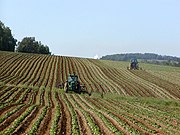
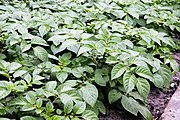
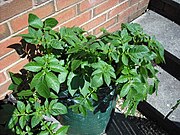
![Production of potatoes (2019)[78]](https://upload.wikimedia.org/wikipedia/commons/thumb/9/94/Production_of_potatoes_%282019%29.svg/622px-Production_of_potatoes_%282019%29.svg.png)

